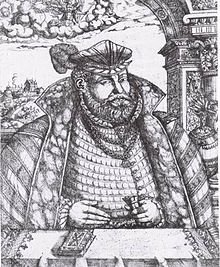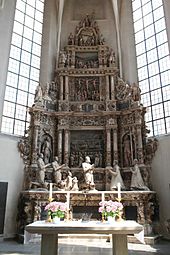Johann Friedrich II. (Saxony)
Johann Friedrich II. The Middle (born January 8, 1529 in Torgau ; † May 9, 1595 (in custody) at Steyr Castle , Upper Austria ) was a prince from the Ernestine line of the Wettins . He held the title of Duke of Saxony .
Life
Johann Friedrich was the eldest son of the Saxon Elector Johann Friedrich the Magnanimous (1503–1554) from his marriage to Sibylle (1512–1554), daughter of Duke Johann III. from Jülich-Kleve-Berg . Together with his younger brother Johann Wilhelm, he was carefully and comprehensively trained by, among others, Basilius Monner . From an early age the brothers took part in meetings of the court council.
At the age of 18, Johann Friedrich took over the administration of the Ernestine lands with his brother Johann Wilhelm after the battle of Mühlberg and the capture of his father. After initial attempts to reorganize the struggle against Emperor Charles V , he finally submitted to it. The emperor gave the sons of Johann Friedrich I an annual sum of 50,000 guilders. Since he was unable to pay these off, he pledged some offices that formed the core of the Ernestine possessions. After the death of his father in 1554, Johann Friedrich II., Who had stipulated the indivisibility of the country and the communal government of the sons in his will, became the sole ruler of the Ernestine possessions in agreement with his brothers. He moved into his residence in Gotha at Grimmenstein Castle . The imperial re-occupation with the Ernestine possessions took place on March 23, 1555. Johann Friedrich entered the service of the French King Henry II , whom he supported on campaigns in France and received an annual payment of 30,000 francs.
Because Johann Friedrich had sided with Wilhelm von Grumbach , who was ostracized in 1563, during the Grumbachian Handel , he was ostracized by Emperor Maximilian II on December 12, 1566 . Imperial troops under the command of the Saxon Elector August besieged the city of Gotha and Grimmenstein Castle. During the siege, Johann Friedrich had "emergency cliffs" hit on the castle to cover the inner-city spending . After the Grimmenstein near Gotha was taken on April 13, 1567, Johann Friedrich was brought to Dresden by Elector August . The arrival in Vienna was on June 22, 1567, followed by the imperial captivity with its own court in Wiener Neustadt , later at the castle in Preßburg , to return to Wiener Neustadt in 1571 because of the greater security. There he maintained a small court and also had his own Protestant pastor. He also managed a leased garden in the suburbs.
In 1567, Elector August left a commemorative coin in his Dresden mint for the capture of Gotha with a demonstratively large Kurschild and the Latin inscription: Finally the good cause wins and the inscription on the reverse: When the city of Gotha was captured in 1567, the punishment of the outlawed besieged Enemies of the Reich carried out and the rest of them put to flight, August, Duke of Saxony and Elector, had (this coin) made. (Translation to MAIN)
In the summer of 1572, before the death of their son Friedrich Heinrich (1563–1572), his wife, Duchess Elisabeth von der Pfalz , moved to his prison. In numerous letters of petition, among others to Emperor Maximilian II , Empress Maria and the Electress Anna of Saxony , she had - in vain - asked for the release of her husband. On February 8, 1594, Elisabeth died in prison after living voluntarily with her husband for over 20 years. In 1595, because of the Turkish threat, Friedrich was brought from Wiener Neustadt to Lamberg Castle in Steyr in the region above the Enns (Upper Austria). There he died on May 9, 1595 of a fall in the stairwell after 28 years in prison. His remains were transferred to Coburg on December 15, 1595. He is buried with his wife in the Moriz Church there. In 1598, Duke Johann Casimir had his parents set up a twelve-meter-high tomb made of Thuringian alabaster by the sculptor Nikolaus Bergner from Pößneck , which is one of the most beautiful Renaissance epitaphs in Germany. In addition to biblical depictions, it shows the ducal couple with their kneeling children who have folded their hands.
The rule over the entire Ernestine possessions initially took over his brother Johann Wilhelm († 1573). In the partition of Erfurt in 1572, however, at the instigation of their guardian, the emperor and the Reichstag, the paternal property ( care of Coburg and the offices around Eisenach and Gotha) was returned to the sons of Johann Friedrich the Middle , which they had after they reached the age of majority and took office of the inheritance after the death of their father in 1595 ( Johann Casimir got Coburg and Johann Ernst got Eisenach and Gotha ). This marked the beginning of the numerous Ernestine partitions, which resulted in numerous small territories in Thuringia .
Marriages and offspring
Johann Friedrich married Agnes (1527–1555), daughter of Landgrave Philip I of Hesse and widow of Elector Moritz von Sachsen , on May 26th, 1555 in Weimar , thereby fulfilling his father's wish. Agnes died of a fever in November of the same year.
He concluded his second marriage on June 12, 1558 in Weimar with Elisabeth (1540–1594), daughter of Elector Friedrich III. von der Pfalz , with whom he had the following children:
- Johann Friedrich (1559-1560)
- Friedrich Heinrich (1563–1572)
- Johann Casimir (1564–1633), Duke of Saxe-Coburg
- ⚭ 1. 1586 (deceased 1593) Princess Anna of Saxony (1567–1613)
- ⚭ 2. 1599 Princess Margarete of Braunschweig-Lüneburg (1573–1643)
- Johann Ernst (1566–1638), Duke of Saxony-Eisenach
- ⚭ 1. 1591 Countess Elisabeth von Mansfeld (1565–1596)
- ⚭ 2. 1598 Princess Christine of Hessen-Kassel (1578–1658)
literature
- Karl August Engelhardt: Johann Friedrich the Middle, blinded by villains, besieged in Gotha, and imprisoned to the end (in the series "Memories from Saxon history, dedicated to the patriotic youth"). Gerlach, Dresden 1797 ( digitized version )
- Ernst Wülcker : Johann Friedrich II. In: General German Biography (ADB). Volume 14, Duncker & Humblot, Leipzig 1881, pp. 330-343.
- Thomas Klein: Johann Friedrich II. In: New German Biography (NDB). Volume 10, Duncker & Humblot, Berlin 1974, ISBN 3-428-00191-5 , p. 530 ( digitized version ).
- Joachim Kruse: Duke Johann Friedrich II. The Middle of Saxony (1529 - 1595) and the Ernestine family epitaph in St. Moriz, Coburg, completed in 1598. A study of the history of culture and art . Part 1. In: Yearbook of the Coburger Landesstiftung 52 (2007), pp. 1–334, Part 2. In: Yearbook of the Coburger Landesstiftung 53 (2008), pp. 1–298.
Individual evidence
- ↑ coingallery.de / Coinings on the occasion of sieges in the 16th century / Continuation page / Siege and capture of Gotha 1567. In it: Notklippe 1567 for three groschen, Gotha. Obv .: Saxon coat of arms with H HF G K. Rev .: Roman numerical value.
- ^ A b Dieter Schnabel: Ritter Wilhelm von Grumbach , URANIA Culture and Education Association Gotha eV, 2012
- ^ Walter Haupt: Sächsische Münzkunde , Berlin 1974, pp. 275 and 279
Web links
| predecessor | Office | successor |
|---|---|---|
| Johann Friedrich I. |
Duke of Saxony 1554–1566 |
Johann Wilhelm I. |
| personal data | |
|---|---|
| SURNAME | Johann Friedrich II. |
| ALTERNATIVE NAMES | Johann Friedrich the Middle |
| BRIEF DESCRIPTION | Duke of Saxony |
| DATE OF BIRTH | January 8, 1529 |
| PLACE OF BIRTH | Torgau |
| DATE OF DEATH | May 9, 1595 |
| Place of death | Steyr Castle |



